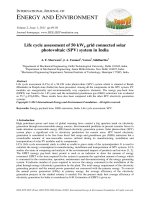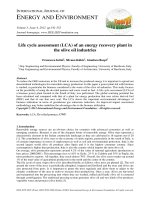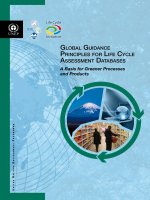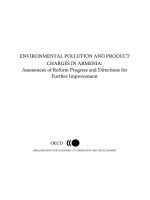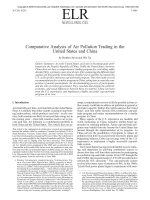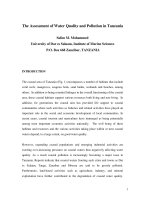Life cycle assessment of Air conditioner and pro-environmental behavior analysis on Air conditioner user in office buildings in Hanoi.
Bạn đang xem bản rút gọn của tài liệu. Xem và tải ngay bản đầy đủ của tài liệu tại đây (1.44 MB, 57 trang )
VIETNAM NATIONAL UNIVERSITY, HANOI
VIETNAM – JAPAN UNIVERSITY
NGUYEN THANH HUYEN
LIFE CYCLE ASSESSMENT OF
AIR CONDITONER AND
PRO-ENVIRONMENTAL BEHAVIOR
ANALYSIS OF AIR CONDITIONER
USER IN OFFICE BUILDINGS IN
HANOI
MASTER THESIS
Hanoi, 2019
VIETNAM NATIONAL UNIVERSITY, HANOI
VIETNAM – JAPAN UNIVERSITY
NGUYEN THANH HUYEN
LIFE CYCLE ASSESSMENT
OF AIR CONDITONER AND
PRO-ENVIRONMENTAL BEHAVIOR
ANALYSIS OF AIR CONDITIONER USER
IN OFFICE BUILDINGS IN HANOI
PROGRAM: MASTER OF ENVIRONMENTAL ENGINEERING
CODE: PILOT
SUPERVISOR
Dr. JUN NAKATANI
Hanoi, 2019
ACKNOWLEDGEMENT
Before studying at Vietnam Japan University (VJU), I have been an official
who has stable occupy in a government agency. However, I always remind myself
must to study as much as possible. I searched a lot of the master’s programmes but
only the syllabus of VJU impress me with international environment of studying. I
have decided to take a break from work for two years to apply to master programme
at VJU. This is one of the right decisions in my life. During near two years studying
in VJU, I always try the best to comprehend all teacher’s lectures. By the funding of
JICA and the assistance of Professors and Teachers of Master’s programme in
Environmental Engineering Master (MEE), I had a chance to internship at the
University of Tokyo in two months, where has a lot of famous Professors, excellent
students and perfect environment for studying. Where gave me a lot of the best
experiments.
Thesis is the final subject of the master program, and the topic of Life Cycle
Assessment is quite new knowledge to me. To finish my thesis, I have had to try a
lot but I will not be able to finish my thesis without the guidance my supervisor and
the support from Professors, Teachers of MEE.
I am very appreciated to Dr. Jun Nakatani and want to give my special
thanks to my supervisor who gave me the best conditions to search and study
effectively, also spend time to give comments for my thesis. Besides that, I also
want to give my special thanks to Prof. Jun Nakajima, Assoc. Prof. Katayama
Hiroyuki, Dr. Nguyen Thi An Hang who helped me a lot from begin days for the
selecting thesis’s topic. I want to give my thank to Dr. Yoshikawa (at Ritsumeikan
University) who helped and gave me comments in implementing my thesis. Also, I
want to say thank to Assoc. Prof. Kasuga Ikuro, and Assistants of MEE’s program
who support me to finish the procedure’s thesis.
Finally, I want to give my special thank to my family who spent me the best
conditions to focus on studying at VJU. I would like to thank to The Japan
International Cooperation Agency, The University of Tokyo, Vietnam Japan
University to give me this great opportunity in which I could develop myself both
academically, professionally and socially.
TABLE OF CONTENTS
LIST OF TABLES ....................................................................................................1
LIST OF FIGURE.....................................................................................................2
LIST OF ABBREVIATIONS...................................................................................3
CHAPTER 1: INTRODUCTION ............................................................................4
1.1.
Introduction ................................................................................................4
1.2
Research goals ............................................................................................6
1.4.
Scope of research ........................................................................................8
CHAPTER 2: LITERATURE REVIEW AND METHODOLOGY ..................10
2.1. Literature review ..............................................................................................10
2.1.1. Life cycle assessment of air conditioner .....................................................10
2.1.2. Pro-environmental behavior analysis.........................................................15
2.2. Methodology and materials .............................................................................18
2.2.1. Life cycle assessment ..................................................................................18
2.2.2. Methodology for pro-environmental behaviour analysis ...........................22
2.2.3. Data collection ............................................................................................23
CHAPTER 3: RESULT AND DISCUSSION .......................................................25
3.1. Assessment of life cycle of air-conditioner .....................................................25
3.1.1. Determine function unit and system boundary ...........................................25
3.1.2. Life cycle inventory analysis .......................................................................26
3.1.3. Lifecycle Impact Assessment (LCIA) ..........................................................29
3.2. Pro-environmental behavior analysis.............................................................34
3.2.1. Determine factors and sub-factors that influent on the target behavior ....34
3.2.2. Determine the local weight and global weight of factors and sub-factors.36
3.3 Summarize the results and discussion .............................................................41
3.3.1. Impact of air conditioner life cycle on global warming and the solution to
reduce that influent. ..............................................................................................41
3.3.2. The factors and sub-factors dominate the behaviour of “energy-saving” in
air conditioner service stage ................................................................................44
3.3.3. Limitations of thesis ....................................................................................46
4. CONCLUSION ....................................................................................................46
LIST OF REFERNCES ..........................................................................................48
APPENDIX A ..........................................................................................................50
LIST OF TABLES
Table 2.1. The scales for importance .......................................................................23
Table 3.1. The quantity of greenhouse gases emitted from AC production process26
Table 3.2. Raw basic database of air conditioner and refrigerant ............................27
Table 3.3. The result of inventory greenhouse gases emission in AC’s operation ..28
Table 3.4. The result of inventory GHGs emission at disposal stage ......................29
Table 3.5. The amount of GHGs emission in production stage ...............................30
Table 3.6. The amount of GHGs emission at operation stage ..................................31
Table 3.7. The GHGs emission in disposal stage of air conditioner ........................33
Table 3.8. Pairwise comparison matrix and local weight of factors ........................37
Table 3.9. Pairwise comparison matrix and local weight inside internal factors .....38
Table 3.10. Pairwise comparison matrix and local weight inside external factors ..39
Table 3.11. Global weight of sub-factors .................................................................40
Table 3.12. Total amount of GHGs emission in Air conditioner’s life cycle ..........42
1
LIST OF FIGURE
Figure 1.1. The ilustrated image of split air conditioner ............................................8
Figure 2.1. Factors influence on behavior ................................................................16
Figure 2.2. The relative importance scale ................................................................23
Figure 3.1. Boundary system of air conditioner’s life cycle ....................................25
Figure 3.2. The portion of GHGs emission in production stage ..............................30
Figure 3.3. The GHGs emission in operation stage of air conditioner with R22 and
R32 at the value GWP20 and GWP100 ........................................................................32
Figure 3.4. Total amount of GHGs emission in disposal stage of air conditioner ...34
Figure 3.5. The hierarchy of influent factor and sub-factors ...................................35
Figure 3.6. The portion emission of each stages in air conditioner’s life cycle.......41
Figure 3.7. The amount emission of air conditioner life cycle at GWP20 and
GWP100 ....................................................................................................................43
Figure 3.8. The global weight of sub-factors ...........................................................45
2
LIST OF ABBREVIATIONS
AC: Air Conditioner
AHP: Analysis Hierarchy Process
BTU: British thermal unit
Eq: Equivalent
GHGs: Green-house gases
GWP: Global Warming Potential
GDP: Gross domestic product
GIZ: German Agency for Development Co-operation Gesellschaft
Technische Zusammenarbeit
HP: Horse power
IDEA: Inventory Database for Environmental Analysis
IPCC: Intergovernmental Panel on Climate Change
MOIT: Ministry of Industry and Trade
MONRE: Ministry of Natural, Resource and Environment
LCA: Life Cycle Assessment
LCC: Life Cycle Cost
LCI: Life Cycle Inventory
LCIA: Life cycle Inventory Assessment
SPSS: Statistical Package for the Social Sciences
JICA: Japan International Cooperation Agency
ODP: Ozone Depletion Potential
PEBs: Pro-environmental behaviors
3
CHAPTER 1: INTRODUCTION
1.1.
Introduction
Being a developing country with a long coastline, Vietnam is one of the
countries that suffered strongly by climate change. Belong to tropical climate region,
Vietnam has four distinct seasons with the summer is very hot. According to IPCC,
with climate change, the global temperature will rise progressively, the predicted
results is an increase about 2-2.5°C in 2100 (IPCC, 2014). That makes the summer
is becoming hotter, the rest seasons are also warmer than before significantly.
In recent years, the growth of economic and the development of society in
Vietnam is increase rapidly. The GDP growth of Vietnam is assessed be among
strongest compared with other countries in the same region [1]. In 2011, the GDP
growth is about 6.2% [2][3], the GDP per capital in USD is 1,402 [4][5]. Till 2017,
the GDP per capital increase about 1.4 times compared with that in 2011 at 2,010
USD and the GDP growth at 6.8%[2][3]. The urbanization is developed widely in
Vietnam. The gap between city and countryside is shrinking. Based on that, the
living’s standard of each person is also greater.
Due to the growth of socio-economic and the climate change, the demand of
air cooling using is becoming more necessary and popular in Vietnam. It is
expressed clearly through the development of air conditioner market in recent years.
According to the results of GIZ, the number of split air conditioner in 2010 was
about 0.79 million units, and this number increased about 3.6 times in 2016 with 2.9
million units. The compound annual growth rate (CAGR) is evaluated
approximately 24%, in 2025, the total of spilt air conditioner can be more than 40
million units [5].
Nowadays, almost air conditioner are using mainly the refrigerants of
Hydrochlorofluorocarbons (HCFC or R22, R410A), and Hydrofluorocarbons (HFC
32 or R32) [5]. The coolants HCFC and HFC are considered to be two type of
4
green-house gases. Refrigerants contain atoms of chlorine and bromine that relate to
ozone depletion and warming up the earth. Due to that, using of air-conditioning
has strongly impacts on environment, especially global warming.
The significantly impacts are considered to derive not only from the release
directly of the refrigerants but also indirectly through electricity consumption.
Because of the operating of combustion at power plant to produce electricity also
emit the significant amount of green-house gases [6]. The research of Hanoi
University of Science and Technology in 2007 showed that the amount of electricity
consumption used for cooling making occupy approximately from 30% to 60% of
the total electricity consumption for all activities in Vietnam. It means the emission
from electricity consumption for cooling is extremely big.
Relate to energy-saving, Vietnam has issued Law of saving and efficiency
energy using on 2010, in which requirement of the energy saving have to be
conducted in all sectors (construction, agriculture, trade and industry). Based on that,
all sectors have built for their-self the legal documents under Law and action-plan
to guide and require stakeholders to implement. Besides that, by the assistance of
international organizations, NGOs, Vietnam has the research projects relate to
energy saving and using efficiency. In which, the projects focus mainly on macro
issues
such as technology revolution, architecture adjustment, technical
improvement, awareness raising. There are not any projects focus on analysis the
behavior of people in energy –saving.
Hanoi is the capital of Vietnam where focus many government offices, sates
agencies and international organizations…According to Hanoi Department of
Planning and Investment, in 2018, the GDPR of Hanoi is 02 times higher than mean
value of the country at 4.080 USD/person/year, about 1.12 times higher compared
with that in 2015. Due to that, the demand of AC’s using in Hanoi is consider
higher than other provinces execpt to Ho Chi Minh city.
5
Almost state agencies and government offices in Hanoi are old buildings that
were contructed for at least 5-10 years ago, with the cooling system is mainly split
residential air conditioner with old refrigerants. Officials and employees are main
persons who use and control directly air-conditioner system in office buildings. Due
to that, the employee’s behavior influence significant on the operation process of air
conditioner and electricity using. At the present, there is no research relates to LCA
of air conditioner at office buildings, also analysis the AC user’s pro-environmental
behavior in Vietnam.
From that, the study “Life cycle assessment of air-conditioner and probehaviour analysis of air-conditioner user at office buildings in Hanoi” is the
neccessary and new topic. This research will show that the impact on global
warming that occur in all stage of life cycle of air conditioner, each stage has
distinct influences at different level. Moreover, the analysis of pro-environmental
behaviour of air conditioner user will figure out the most important factor that have
influence on their behaviour of energy saving.
1.2
Research goals
The general goals of thesis include two main goals. The first is life cycle
assessment of air conditioner. In which, focusing on assessment the impact of AC's
life cycle on the warming up global. For that, thesis just focus on calculating the
amount of green-house gases that emit from all stages of Air conditioner’s life cycle.
Through the calculated results, showing what is the stage has the biggest amount of
GHGs. Comparing the amount of emission GHGs in two case of air conditioner use
the coolant R22 and R32, figure out which refrigerant is more environmentally
friendly. Besides that, calculating the amount of GHGs emission at different rates of
recovery of coolant, the result will figure out how many percentage of GHGs
emission can be reduced at each rates of recovery.
The second goals is pro-environmental behaviour analysis of air conditioner
user. There are some PEBs that relate to using air conditioner, but thesis just
6
focuses on the behaviour of energy-saving in operating process of air conditioner.
In which, the influence factors on the behaviour are analysed and assessed. The
most important factor dominates the behaviour of energy-saving in AC using at
office building in Hanoi will be found.
For detailed, goals include:
+ Calculate the GHGs emission in all stages of AC’s life cycle in case of AC
is used at office buildings of state agencies. Determine the impact of AC’s life cycle
on global warming.
+ Compare the amount of GHGs emission between each stages of life cycle,
two type of coolants R22 and R32, and different rates of coolant recovery.
+ Analysis the influence factors on pro-environmental behaviour “energysaving” in service of air conditioner and indicate which is the most important
factors that dominate that behaviour.
1.3.
Research subjects
There are two main subjects that are studied in thesis. The first subject is
split air conditioner that is one of unitary air conditioners. The split air conditioner
consists indoor units and outdoor units. In which, outdoor units consist of the
compressor, condenser and capillary tubing that installed near exterior wall of the
room. Indoor units consist of evaporator and an air filter is firmed in the room [8].
The setting up of split air conditioner is simpler than other type of air conditioner.
Indoor and outdoor units are connected together through tubing without ductwork
as traditional. The outdoor are located outside the room will reduce the major
sources of noise.
This type of AC usually is used in state agencies in Hanoi. Normally, each
working rooms are installed one split air conditioner and the total of AC in one state
agency will be similar number with rooms. In the thesis’s content, all word “air
conditioner” in general is understood as "split air conditioner" type.
7
Sources: [19][20]
Figure 1.1. The ilustrated image of split air conditioner
The second subject for pro-environmental behavior analysis is employees
and officials who directly use and control air conditioner in their offices. Normally,
almost employees work for state agencies have been trained at the universities or
colleges. Compare to other agencies, they are higher in education. They are first
persons who approach with the approved policy of national. Their salary is usually
increased automatically as each level based on the fixed scale. The reward or
discipline factor impact less on their salary.
1.4.
Scope of research
The scope of research is working offices of state agencies in Hanoi. Hanoi is
the capital of Vietnam that has big growth both of economic and society. State
agencies which are placed at Hanoi include mostly government offices, ministries,
agencies, departments…Almost of working offices were constructed for at least 510 years ago with old architect. The model of working room in state agencies is
often small room from 15m2 in area where has from one to five employees who
work in.
The assessment of life cycle AC is implemented from mining to disposal
phase. The system boundary includes “mining – production/using process–
8
operation/ recycle/disposal stage”. In which, thesis just focusing on calculating the
amount of green-house gas that emit from production to operation and disposal of
AC. In other hand, the emission from recycle operation of materials of AC and the
emission from transportation of refrigerant and AC are ignored.
With the objective of compare the amount GHGs emission between two type
of refrigerants, R22 and R23 is selected to compare. Based on the result of the
Montreal Protocol, R22 or F-gas (HCFC-22) is currently used widely for airconditioner in developing countries. It has a high value Global warming potential.
In other hand, R32 (HFC-32) is considered a substitution gas that has a lower GWP.
This gas often is used for air conditioner in developed countries [9].
The pro-behavior analysis of AC user in office buildings focus mainly on
officials and employees who work at the state agencies. They are the people who
use ad control directly air-conditioner in offices. In which, the internal factors and
external factors that impact on user’s behavior are taken to be considered. Based on
Steg and Vlek (2009), internal factors and external factors includes sub-factors,
however, with the main objective above, thesis just focus on analyzing six subfactors. For detailed, internal-factors includes knowledge; attitude; cost and benefit,
beside that external factors includes policy; product characteristic; surrounding
conditions.
9
CHAPTER 2: LITERATURE REVIEW AND METHODOLOGY
2.1.
Literature review
2.1.1. Life cycle assessment of air conditioner
In general, life cycle assessment is considered as one effective tool for
identifying quantitatively environmental impacts. All life cycle of a product or a
process are evaluated from "cradle to grave". In which, all stage of product's life
cycle is evaluated with the perspective they are interdependent. Through LCA, the
environmental impacts that cumulated in all phase of product's life cycle are also
calculate, which include the impacts relates to resource exploit or raw material.
There are some definitions about LCA, however, there two definitions that accepted
widely in the world as below:
According to Guidelines for Life Cycle Assessment, 1993, LCA is defined as
follow: “The life cycle assessment is an objective process to evaluate the
environmental burdens associated with a product, process, or activity by identifying
and quantifying energy and material usage and environmental releases, to assess the
impacts of those energy and material uses and releases to the environment, and to
evaluate and implement opportunities to effect environmental improvements. The
assessment includes the entire life cycle of the product, process, or activity,
encompassing
extracting
and
processing
raw
materials;
manufacturing
transportation and distribution; use/re-use/maintenance; recycling, and final
disposal.” [22].
In other hand, based on ISO 14040, LCA is defined as: "LCA is a technique
for assessing the environmental aspects and potential impacts associated with a
product by (1) Compiling an inventory of relevant inputs and outputs of a product
system; (2) Evaluating the potential environmental impacts associated with those
inputs and outputs; (3) Interpreting the results of the inventory analysis and impact
assessment phases in relation to the objectives of the study. LCA studies the
10
environmental aspects and potential impacts throughout the product's life (i.e.
cradle to grave) from raw materials acquisition through production, use and disposal.
The general categories of environmental impacts needing consideration include
resource use, human health, and ecological consequences”. The main stages of LCA
consists of goal and scope definition (determine aims, function unit, boundary
system); life cycle inventory (calculate all input, output of all material during all life
cycle); impact assessment (the results of inventory is analyzed relates to
environment); interpretation (assess the results regard to the LCA’s goals).
Nowadays, LCA is applied widely by companies, organization, environmental
groups with the goals of reducing environment impacts.
The state of Life cycle assessment of air conditioner in the world
Air conditioner is considered to be as popular and necessary equipment in
the world, there are some researches about Life cycle assessment of air conditioner.
In which, almost researches apply LCA to compare between two system of air
conditioner, two type of refrigerants. For detailed, in Daikin Air-Conditioning R&D
Laboratory, they do the study of “Life cycle assessment study of air conditioners
with an alternative refrigerant”, to compare two types of refrigerants of HCFC22
and HFC410A that used for cooling making. The result show that compare to
HCFC22, using HFC410A will eliminate the impact on the ozone-layer depletion
and the global warming, also, the impacts on global warming will be reduced if the
refrigerant is recovered after using [22]. The research also show that HFC32 has the
potential to reduce the impact on global warming more than HFC410A. Practical
solutions to reduce the environmental burden due to the refrigerants are figured out
from the research, that are increasing the high ratio of the used refrigerant and
decreasing the volume of the refrigerant used in air conditioner but still keep
maintaining high performance of the product. Besides that, Daikin Europe also do
LCA for air conditioner and heat pump to give experiences in production process.
In which, they focus on refrigerants assessment to global warming. The factor of
seasonal energy efficiency is included. The author also mentioned to direct emission
11
and indirect emission in the study. Their results showed that among refrigerants,
HFC 32 or R32 is the most balance with characteristics as Zero ODP; high energy
efficiency, small GWP, small conversion cost, supply capability is sufficient. That
means R32 is ideal option for air conditioner to reduce the impacts on environment.
[26].
In the other hand, in the study of “Environmental impact and life cycle
assessment of heating and air conditioning systems, a simplified case study” [23],
Matjaz Prek applied LCA to compare three designs of heating and air conditioner
system in order to show the best option for product. In this study, the author applied
Eco-indicator 95 method to permit assessor can integrate environmental factor to
industry and science into the design process. Three systems were considered in all
life cycle, in which all elements are assessed in the same procedure. The problem
was evaluated weighting factors. The results showed that the different of Ecoindicator value of each designs. The results show that in three systems, copper pipes
and other copper parts has the biggest impacts on environment. The floor heating
system give the lowest impact.
In other hand, in the study of “Design and construction for Hydroxides
based on air conditioner system with solar collector for confined roofs”, LCA is
applied to compare the environmental impacts of solar air conditioner system
(ACASS) and conventional system (CAC) in term of CO2 equivalent. In this
research, the boundary system not include the assessment of disposal stage. The
software SimaPro 8 is used to assess the impacts of two systems. The results show
that, during the construction of CO2 eq is higher 14.05% than CAC’s system. But in
the operation stage, the ACASS system just emit 5.37% CO2 eq, while CAC system
emit about 100% CO2eq. Because in operation stage, the ACASS system use totally
solar energy for service, while CAC system use electricity for service. That
demonstrated that installation of ACASS system will reduce significant amount of
emission due to energy consumption [25].
12
Besides that, LCA is also combined with Life cycle cost analysis to give out
the assessment of not only environmental impacts but also economic performance.
The study of Kamel Almutairi is good example. The study has title as “Life cycle
assessment and economic analysis of residential air conditioning in Saudi Arabia”.
In which, the function unit is determined as the climate control of 1m2 of living area
with the maintained temperature at 75F in one year. The boundary system is from
manufacturing and using to disposal stage. The software of Sima-Pro 8 is used in
this study. The results showed that using phase has the largest impacts on
environmental, the level impact on each region is influenced by type of used
primary fuel. Compared to environmental concerns, the economic factor is more
important than environmental concerns in developing country [24].
Besides the LCA studies, the content relates to estimate the emission from
air conditioner also is implemented in other studies. In the study of “Reduction of
potential greenhouse gas emissions of room air-conditioner refrigerant: a life cycle
carbon footprint analysis, the author used life cycle CFP method to calculate the
global warming effects, from that assess the potential reduction of GHGs emission
of room air conditioner refrigerant. To give the solution for GHGs reduction, the
author assessed four type of refrigerants as HCFC-22 (R22), HFC-410A (R410A);
HFC-32 (R32), HFC- 161 (R161) and HC-290 (R290). In which, HCFC-22 and
HFC-410A are the popular refrigerant in the present, HCFC-22 has been used
mainly in developed countries, while R410A is refrigerant that replaced for R22,
that used widely in developed countries. The results showed that refrigerants as
HFC-32 (R32), HFC- 161 (R161) and HC-290 (R290) are new applicants for
replacement for current refrigerants in the future. In which, R32 is considered as
transitional product. To reduce the GHGs emission from room air conditioner, need
to improving the recycle rates of used refrigerants, the amount of reduction can
reach at 21.6%. Moreover, when replacement low GWP refrigerants for high GWP
refrigerant, the amount of GHGs emission can be decreased about 55.9%. The
authors showed that the main direct source of GHG emissions was found due to the
13
release of refrigerants in the process of disposal, and the major indirect GHG
emissions related to energy consumption during the process of service. However,
because the structure of the energy production in China is quite difficult to be
changed or improved in short term, so that reduction of indirect GHGs emission is
not easily.
The state of Life cycle assessment of air conditioner in Vietnam
The definition of Life cycle assessment is introduced in Vietnam from 2000s.
To apply this useful tool widely, in 2009, Ministry of Science and Technology
approved and published the national standard TCVN ISO 14040:2009 about
Environmental management – Life cycle assessment – Principles and framework.
From that, LCA has been applied widely in Vietnam. There are a lot of study,
projects relate to Life cycle assessment in Vietnam. However, the LCA study in
Vietnam major relates to contents of infrastructure, agriculture. For detailed, the
study about “Life cycle assessment and environmental improvement of residential
and drinking water supply system in Hanoi, Vietnam” is written by Kathihanna
Homaki et al. The main object of research is drinking water supply system in Hanoi.
Besides that, in the study “Life cycle assessment of Biogas Production in
Small-scale Household Digesters in Vietnam” of T.K.V.Vu, D.Q.Vu et al, Biogas
production is main objective for assessment. In which, the authors applied the
ReCiPe 2008 method to assess. Other study is “Life cycle assessment of Municipal
Solid Waste Management towards Sustainability in developing countries: A case
study of Hanoi City, Vietnam”, this study focus on environmental impact that relate
to waste disposal, leachate treatment, BOD and GHGs emission. In the study of
“Life cycle assessment of biochar application in Vietnam using two pyrolysis
technologies”, Ali Mohammadi et al applied LCA to analysis and compare the
environmental impact of biochar system using household scale with that using
district scale pyrolysis technologies.
14
Associate to life cycle assessment of air conditioner in office buildings
Vietnam, there is still no study. However, relating to inventory GHGs emission of
air conditioner, there are the project of “Greenhouse Gas Inventory of the
Refrigeration and Air conditioning sector in Vietnam” under the Programme “Cool
Contribution fighting Climate Change (C4)”. This programme is implemented in
2019 by the cooperation between GIZ in cooperation with Department of Climate
Change of Ministry of Natural Resources and Environment of Vietnam. In this
project, the GHGs inventory is conducted with all refrigeration and air conditioner
currently available in Vietnam. From that, the report of the type of refrigeration and
air-conditioner, their energy consumption and the amount of GHGs emission of
each type RAC are presented clearly. To determine the potential reduction of GHGs
for Vietnam, the authors compared the current RAC technologies and high
technologies in the world. Based on that, potential trends in each of the RAC types
are analysed at both scenarios BAU (business as usual) and MIT (Mitigation).
2.1.2. Pro-environmental behavior analysis
According Kiyo Kurisu, there are no definition and way to categorize proenvironmental behavior, some alternative terms for PEBs are considered as
environmental behavior, ecological behavior, environmentally responsible behavior,
environment-friendly behavior. Basically, there are two ways to determine PEBs,
PEBs is understood in narrow purpose as “actually contributing to or perceived to
contribute to environmental conservation” and in widely purpose as “contribute to
cultivation of environmental consciousness”.
However, based on Krajhanzl, pro-environmental behavior is understood as
an individual’s behavior, which is “generally or according to the knowledge of
environmental science, judged in the context of the considered society as a
protective way of environmental behaviour or a tribute to the healthy
environment” (Krajhanzl, 2010, p. 252). In the model proposed by Clayton and
Myers, all factors influence on individual’s behavior are categorized into two
groups internal factor and external factors. This model is figured out as below:
15
Social Norm
Environment
Affordances
Knowledge
Prompts
Responsibilit
y
Social Norm
Attitudes
Person
Goals
Efficacy
Values
Emotions
Feedback
Reinforcem
ent
Contingencies
Source: Conservation Psychology
Figure 2.1. Factors influence on behavior
PEBs is concerned by many subjects as economic, anthropology, ecology,
sociology, psychology. In which, psychologists and sociologist pay the most
attention on PEBs. They research on PEBs to find the reason for why do individuals
act pro-environmentally and what is the barrier of PEBs (Kollmuss and Agyeman,
2002). From that goals, there are some theories of moral motivation in social
psychology developed such as NAT - Norm-Activation Theory (Schwartz, 1070,
1973, 1977), Planned Behavior – TPB (Ajzen, 1991) and VBN – Value-beliefnorms theory (Stern et al., 1999). In which, Planned Behavior –TPB is used the
most to clarify pro-environmental behaviors.
The state of analysis PEBs in the world
In the study “Determinants of Consumers’ Pro-environmental BehaviorToward an Integrated Model”, Octav-Ionut Macovei applied theories Schwartz’s
Norm Activation Theory (NAT), Stern’s Value-belief-norms Theory (VBN) and
Ajzen’s Theory of Planned Behavior (TPB) to clarify consumers’ pro-
16
environmental behavior. The authors analyzed its direct and indirect predictors. The
variables were considered as normative beliefs, awareness of the consequences of
environmental issues, attitude toward a pro-environmental behavior and intention to
behave in a pro-environmental. The quantitative survey is employed to validate all
above variables. For detailed, each variable is measured based on Likert Scale and
divided into 5 point such as: 1 – Strongly Disagree, 2 – Disagree, 3 – Neither agree
or disagree, 4 – Agree to 5 – Strongly Agree. Similar to variables, each proenvironmental behavior is measured based on 5 point of frequency level: (1) never;
(2) sometimes; (3) often; (4) very often; (5) always.
In the study of “Understanding pro-environmental behavior: A comparison
of sustainable consumers and apathetic consumers”, the author Joohyung Park et al
analyzed the psychological factors such as affective attitude, social norm,
personal norm, and behavioral intention, cognitive attitude in order to consider
the differences in basic psychological features linking to pro-environmental
behaviors. Two compared consumer groups are green product purchasers and
green product non-purchasers. The author used web-based survey to collection
consumer’s opinion. The method of Multivariate Analysis of Variance
(MANOVA) was applied to check the proposed hypotheses in the research.
Besides
that,
through
studying
“Encouraging
pro-environmental
behaviour: An integrative review and research agenda”, Linda Steg and Charles
Vleck showed that factors influencing environmental behaviors such: Motivational
factors (weight cost and benefit; moral and normative concern, affect); Contextual
factors; Habitual behavior. In other hand, in the paper “Environmental Attitudes and
Behavior: Measurement”, authors Sebastian Bamber and Jonas Ree mentioned
about the approach to measure behavior. In which, the intent-oriented is used
person’s standpoint to define their behavior. From that, an action is considered as
pro-environmental behavior when it brings the benefit to environment. However,
the impact-oriented approach related to people’s activities impact more or less on
environment. It means this approach associate to the level of impact on environment.
17
In this study, authors took survey face to face with 2307 persons from German
population. A list of 16 questionnaires relates to environmentally relevant behaviors
were conducted. The results demonstrated that the role of environmental
psychologist is very important in order to improve behavioral change. A proposed
general framework to increase the effective of behavioural interventions such as: (1)
determine the behaviour need to be changed, (2) analysis of the main factors under
this behavior (3) develop and using interventions to change the behavior (4)
assessment of the effectual of interventions.
The state of PEBs analysis in Vietnam
In Vietnam, the research topic associated to pro-environmental analysis are
limited. Specially, the study of “The factors influent on the behaviour of green
consumption of people live in Nha Trang” is one of studies about PEBs. In which,
the authors applied theory of planned behaviour (TPB) of Ajzen with two extra
variables (perceived risk and trust) to analyse factors that effect on green
consumption behaviour. The authors took survey with 250 consumers in Nha Trang.
Applying SPSS method to evaluate. The results showed that there are five factors
(emotion, knowledge, social, behavior control, risk and trust) have positive impacts
on that behavior.
2.2.
Methodology and materials
2.2.1.
Life cycle assessment
Thesis just focus on calculating the amount of GHGs emission from each
stages of life cycle. In calculation, the amount of GHGs emission are expressed to
expressed as CO2 equivalent to impact assessment. The amount of GHGs emission
of each phases are determined as below:
In the production of air conditioner
Consulting the database inventory of IDEA (Japan), the emission is
calculated base on the equation of IPCC as below:
18
In which:
Emission: the amount of GHGs emission that be expressed as CO2
equivalent (CO2/CO2eq (kg));
Gas emission: the amount of emission of Gas;
GWP: Global warming potential value with GWP20 (at 20 years) and
GWP100 (at 100 years).
In the operating/using air-conditioner
At the operating stage, the sources emission of GHGs are divided into two
types, direct emission and indirect emission. In which, the direct emission derived
from the release of refrigerant. In other hand, the indirect emission comes from
electricity consumption (Calm, 2002). According to Linjia Zhao et al, the general
formula for estimating life cycle CFPs of coolant is as follows:
(
)
(
)
In which:
GWP: the value of global warming potential of refrigerant j;
mref: the direct emission of refrigerant at production stage (1);
mAC: the direct emission of refrigerant at fillings of refrigerant (2);
mser: the direct emission of refrigerant at serving or operating stage (3);
mrec: the direct emission of refrigerant at disposal stage (4);
nref, nAC; nser; nrec: the indirect emission of similar stage from (1) to (4) as
above;
19
E: the emission factor of electricity.
For detailed, the direct emission of refrigerant in using stage is calculated
based on the amount of refrigerant required by each AC's cooling capacity, the
emission rate of the refrigerant during using time, and time life of AC.
In which:
•
E direct: total direct emission;
•
a: cooling capacity of AC;
•
M: amount of refrigerant required to product unit cooling capacity in
unit AC;
•
C: annual emission rate of the refrigerant during using time of AC
(%);
•
T: time life of AC;
•
GWP: global warming potential at 100 years and 20 years.
The indirect emission in using stage is calculated based on the amount of
electricity that is used to operating AC in all life time and the emission factor of
electricity of Vietnam.
In which:
•
E indirect: total indirect emission;
•
P: power of AC;
•
t: time of using;
•
EF: emission factor of electricity.
In the disposal stage
20
